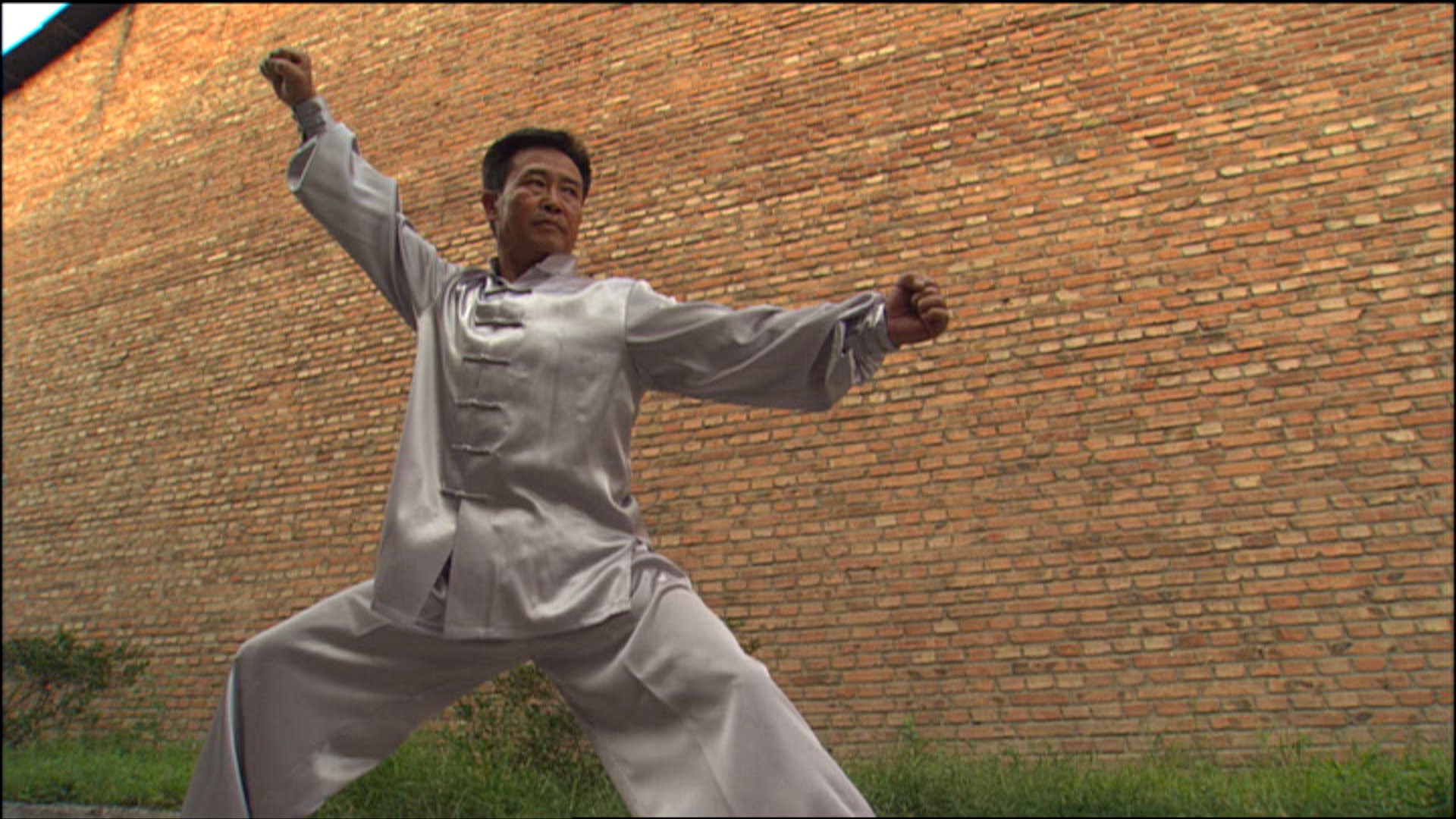Chinese Hero: Wuxia Ep.5
[Mui Fa Zong(梅花樁) Against Foreign Powers]
2003 documentary
Martial Arts in Life
- Outside view of the apartment
A commoner's apartment on the outskirts of BeiCheng, China.
- Demonstration of Mui Fa Zong
Sui Yunjiang (隨云江), who lives here, is the master of plum blossoms.
Mui Fa Zong (梅花樁) belongs to the practical martial arts,
another branch of Chinese martial arts.
It originated in Shandong Province during the Han Dynasty
and is characterized by unique weaponry using agricultural tools.
- Painting of the ancestor
- The first martial arts that Sui Yunjiang learned were Baguazhang.
However, at the age of 32, his teacher and Li Ziming (李子鳴) introduced him
to the master of Mui Fa Zong, and he became a learner with difficulty.
- Interview with Sui Yunjiang
(The reason people practice martial arts is to protect their country and their home.
Only with great martial arts can I protect my family and my country.
The essential idea of Chinese martial arts is to protect the country,
the people, and the family.)
- Demonstration of Mui Fa Zong
Sui Yunjiang's thoughts are in line with
the martial arts spirit of Chinese martial arts.
- Data on the Opium War
Starting with the Opium War, China was invaded by
Western powers one after another.
China, immersed in Chinese ideology,
was nothing more than a paper tiger.
- Late Cheng Dynasty photo
Political circles insisted on overcoming the crisis
through the reform and self-reliance movement.
Meanwhile, in the private sector,
there was a movement to drive out the Western powers with martial arts.
The Yihetuan (義和團) incident occurred against this background.
- Pictures of farmers
After the China-Japan War, in Shandong Province,
there were frequent conflicts between German soldiers and peasants.
- A picture of the peasants with their weapons and Xi Taihou
Armed with Mui Fa Zong(梅花樁), Shandong peasants form the Yihetuan
under the banner of ‘Support the Qing, destroy the foreign’ (扶淸滅洋).
Their argument to drive out Westerners and defend the country
has been well received by the public and spread to northern China.
- Interview with Professor Lin Hai, China Sports Science Center
(At this time, Xi Taihou (西太后), the Cheng dynasty took advantage
of this sentiment of the people.
She tried to use her boxers to oppose foreigners.
So she ordered them to gather in BeiCheng)
- Yuanmingyuan
However, the Yihetuan (義和團) are suppressed by
the Allied Forces of the 8 Western Powers with strong military power.
The people's efforts to save the country through martial arts were in vain.
The Yihetuan incident is also being evaluated meaningfully in the history of martial arts.
- Interview with Lin Boyuan, Professor at Japan International Martial Arts College
(In the old days of martial arts, there were schools everywhere.
However, there was little communication between schools and schools.
There was one in each rural area, so there was little exchange.
Because many peasants gathered during the Yihetuan movement
exchanges of martial arts schools have been active,
This played a major role in the development of folk martial arts.)

2003년 다큐멘터리
생활 속의 무술(武術)
무협(武俠) 5화
[외세에 대항해온 중국무술 - 매화장(梅花樁)]
- 아파트 외경
중국 베이징 변두리의 서민 아파트.
- 수운강(隨云江) 매화장(梅花樁) 시범
이곳에는 사는 수운강(隨云江)씨는 매화장(梅花樁)의 고수다.
매화장(梅花樁)은 중국 무술의 또 한 줄기인 실전 무술에 속한다.
한나라 때 산동성 지역에서 유래됐고, 농기구를 이용한 독특한 무기술이 특징이다.
- 팔괘장(八卦掌) 시조 그림
- 수운강(隨云江)씨가 처음 배운 무술은 팔괘장(八卦掌),
그런데 32살때 스승 이자명(李子鳴)으로부터 매화장(梅花樁)의 고수를 소개받고 어렵게 전수자가 된 것이다.
- 수운강(隨云江) 인터뷰
(사람들이 무술을 연마하는 이유는 나라를 지키고 집을 지키기 위한 것입니다.
훌륭한 무술이 있어야만 나의 가족과 나라를 지킬 수 있습니다.
중국 무술의 본질적인 관념은 나라와 민족 그리고 가족을 보호하기 위한 것입니다.)
- 매화장(梅花樁) 시범
수운강(隨云江)씨의 이런 생각은 중국 무술의 무협(武俠) 정신과 맥이 닿고 있다.
- 아편전쟁(鴉片戰爭)자료
아편전쟁(鴉片戰爭)을 시작으로 중국은 잇단 서구 열강의 침입을 받게 된다.
중화사상에 젖어 있던 중국은 종이 호랑이에 불과했다.
- 청나라 말기 사진
정치권에서는 개혁 자강운동 (變法自強運動) 으로 위기 극복을 주장했다. 한편, 민간에서는 무술로 서구열강을 몰아내려는 운동이 벌어졌다.
의화단(義和團)사건도 이런 배경에서 일어났다.
- 농민들 사진
청일전쟁 후 산동성 지역에서는 독일군과 농민들의 마찰이 잦았다.
- 농민들 병장기 든 사진과 서태후
매화장(梅花樁)으로 무장한 산동성 농민들은 부청멸양(扶淸滅洋)의 기치 아래 의화단(義和團)을 결성한다.
서양인을 내쫓고 나라를 지키자는 이들의 주장은 대중의 호응을 얻어 중국 북부로까지 확산된다.
- 임해(林海) 중국스포츠과학센터 교수 인터뷰
(이때 서태후(西太后)는 청나라 정부는 민중의 이런 심리를 이용하였다.
의화단(義和團)을 이용해 외국인들에게 대항 하려 했다.
이렇게 명령을 내려 그들을 베이징으로 집결하도록 했다)
- 원명원(圓明園)
하지만 의화단(義和團)은 막강한 군사력을 가진 서양 8개국 연합군에 의해 진압된다.
무술로써 나라를 구하겠다는 민중들의 노력은 물거품이 돼버렸다.
의화단(義和團) 사건은 또한 무술사적으로도 의미있는 평가를 받고 있다.
- 임백원(林伯原) 일본국제무도대 교수 인터뷰
(예전의 무술은, 여기저기에 유파가 있었습니다.
그런데 유파와 유파 사이에 교류가 적었습니다.
농촌 각지에 하나씩 있어서 교류가 적었습니다.
의화단(義和團) 운동 도중에는 많은 농민들이 모였기 때문에
무술유파의 교류가 활발해졌는데,
이것이 민간 무술 발전에 큰 역할을 했습니다.)
[영상 링크] https://www.youtube.com/watch?v=8t1b_dCH7M0



